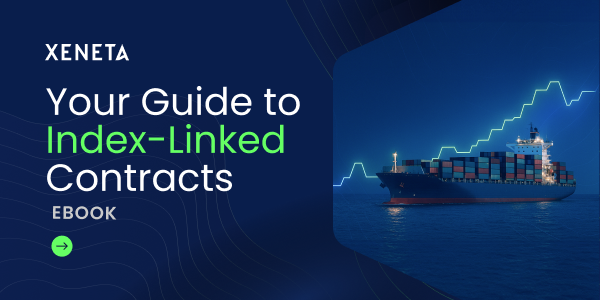“We’re seeing a raft of curveballs being thrown at us… and that goes for everyone in the container shipping space — whether you’re a big carrier, a shipper, an intermediary, a freight forwarder, or any other form of business that services importers and exporters on a global scale.”
Peter Sand, Chief Analyst at Xeneta
In late October 2024, labor disruptions on the U.S. East Coast caused significant upheaval, but the situation was largely resolved by early January 2025. Fortunately, operations at ports have since stabilized and the turbulence is easing.
But that’s just the tip of the iceberg.
With continued turbulence from the US political landscape and the re-introduction of the SHIPS for America Act, legal complexities still need to be at the front of your mind. Freight is now a compliance game as well as a procurement one.
And even that's not the end of it.
As well as constantly shifting market dynamics, geopolitical changes, and an evolving compliance landscape, you also need to pay attention to the environmental impact of your freight activities. Especially as global ocean shipping was found to have emitted all-time high carbon emissions in 2024, driven largely by the impact of conflict in the Red Sea.

Looking back and comparing the volatility we see today to previous years, it’s clear the market was a lot smoother before the COVID-19 pandemic. And it’s perhaps the sheer number of disruptors we’ve seen since that are creating unprecedented levels of market turbulence.
The risk of inflexibility
While the market continues to shift, being able to adapt with it is key to keeping your schedules and budgets under control. Trying to lock everything into an annual rate exposes you to a huge array of risks, some of which include:
Lack of renegotiation leverage: When the market spikes and your rates are down you don't have many choices; either you pay, renegotiate, or can’t move your cargo.
Lack of agility: Whether it’s tariff changes, demand changes, or a new crisis, you need the insight and confidence to pivot quickly and be agile to the market, which is very hard to do if you’re locked into an annual tendering cycle.
Hidden costs: This isn’t just about costs themselves, but also the time you waste. Too much delay and your inventory might not make it to the shelves. Perhaps you need to use air freight to move cargo faster. All of this adds cost and puts pressure on your ability to budget effectively.
Retrospectivity: With an inflexible strategy you’re at huge risk of always looking backwards and trying to react. That means you're constantly trying to catch up instead of forecasting and anticipating what's going to come next.
“Imagine that you're driving in the fog and can only navigate by looking at the rear-view mirror. You might eventually get to where you need to be, but it's going to take you a lot of wrong turns. You might hit things, it might cost you extra money, and that’s not how to get to your destination in the most effective way. This is the reality for many companies that are operating based on old information, or without information.”
Fabio Brocca, Chief Product Officer at Xeneta
Five ways leading BCOs are gaining a competitive advantage
From blank sailings and volatile rates to geopolitical instability and shifting trade policies, procurement and logistics teams need more than experience and instinct to navigate what’s next. They need real-time, reliable data to make confident, timely decisions.
That level of visibility isn’t just about reacting faster. It’s about planning smarter. With the right insights, shippers can build flexible, proactive strategies that protect their budgets, strengthen carrier relationships, and reduce operational risk across the supply chain.
Here are five powerful ways freight visibility, backed by real-time data, can give you a competitive edge:
#1 Using data and trends to forecast
Tools like Xeneta’s Market Rate Outlook help you anticipate where the market is heading 3–6 months ahead. With these projections, you can shift from reacting to planning — negotiating better rates, preparing your supply chain for shifts, and confidently making faster decisions.
#2 Diversifying carriers
While committing volume to one carrier can unlock better rates, it also increases risk. Building relationships with multiple providers — and using data to compare them on price, reliability, transit times, and service levels — gives you the flexibility to pivot fast and keep goods moving when disruptions hit.
#3 Scenario modelling
This allows you to test out strategies before committing. Want to understand the impact of sourcing from another region? Or how tariffs might affect total landed cost? Scenario modelling helps you forecast financial and operational implications before making a move.
#4 Evaluating new trade routes
Shipping routes are never as simple as finding the fastest way from A to B. But in today’s climate, it’s more complicated than ever. Trade lanes are constantly shifting — due to conflict zones like the Red Sea or evolving tariff rules. With access to geopolitical and market data, you can adapt routes to reduce risk, maintain efficiency, and avoid unnecessary costs.
#5 Renegotiate at the right time for you
When the market softens, carriers may reduce capacity to protect prices. If you’re not tracking rates in real time, you’ll miss your window to renegotiate. Data on current rates, carrier behavior, and peer benchmarks gives you leverage — so you can act fast and secure fair contracts.
Real Results: How leading BCOs are already using data to win
British American Tobacco (BAT) reshaped its global freight strategy with Xeneta, achieving nearly 40% savings on key high-volume lanes and cutting negotiation time by over 30%. By combining cost, reliability, and sustainability metrics, BAT now uses Xeneta daily to optimize tenders and drive strategic alignment across procurement, logistics, and finance.
Visy Global Logistics, acting as both shipper and forwarder, transformed its decision-making with real-time rate intelligence. In just one year, Visy identified cost discrepancies, renegotiated stronger contracts, tripled internal platform adoption, and embedded Xeneta into monthly performance reporting — making data a central part of its procurement strategy.

Be ready for what’s next...
The reality is: disruption is the new normal. And while you can’t control global crises, shifting policies, or sudden rate spikes, you can control how you respond.
By investing in the right insights now, you don’t just get through the next tender season. You future-proof your supply chain strategy. You gain leverage, agility, and transparency in a world where too many are still flying blind.
Data isn't just about saving costs. It’s about making smarter, faster, and fairer decisions — and building a strategy that can flex with the market, not break under it.
For more insights from Fabio and Peter, watch their recent webinar here: From Cost to Complexity — How US BCOs Are Rebuilding Freight Strategy in a Shifting Trade Landscape.
Better yet, book yourself a demo to see how Xeneta can help you turn volatility into strategic advantage, before your next tender even begins.
%201.png)






